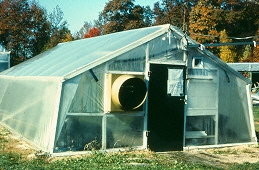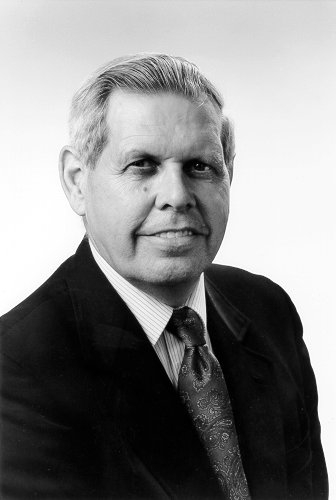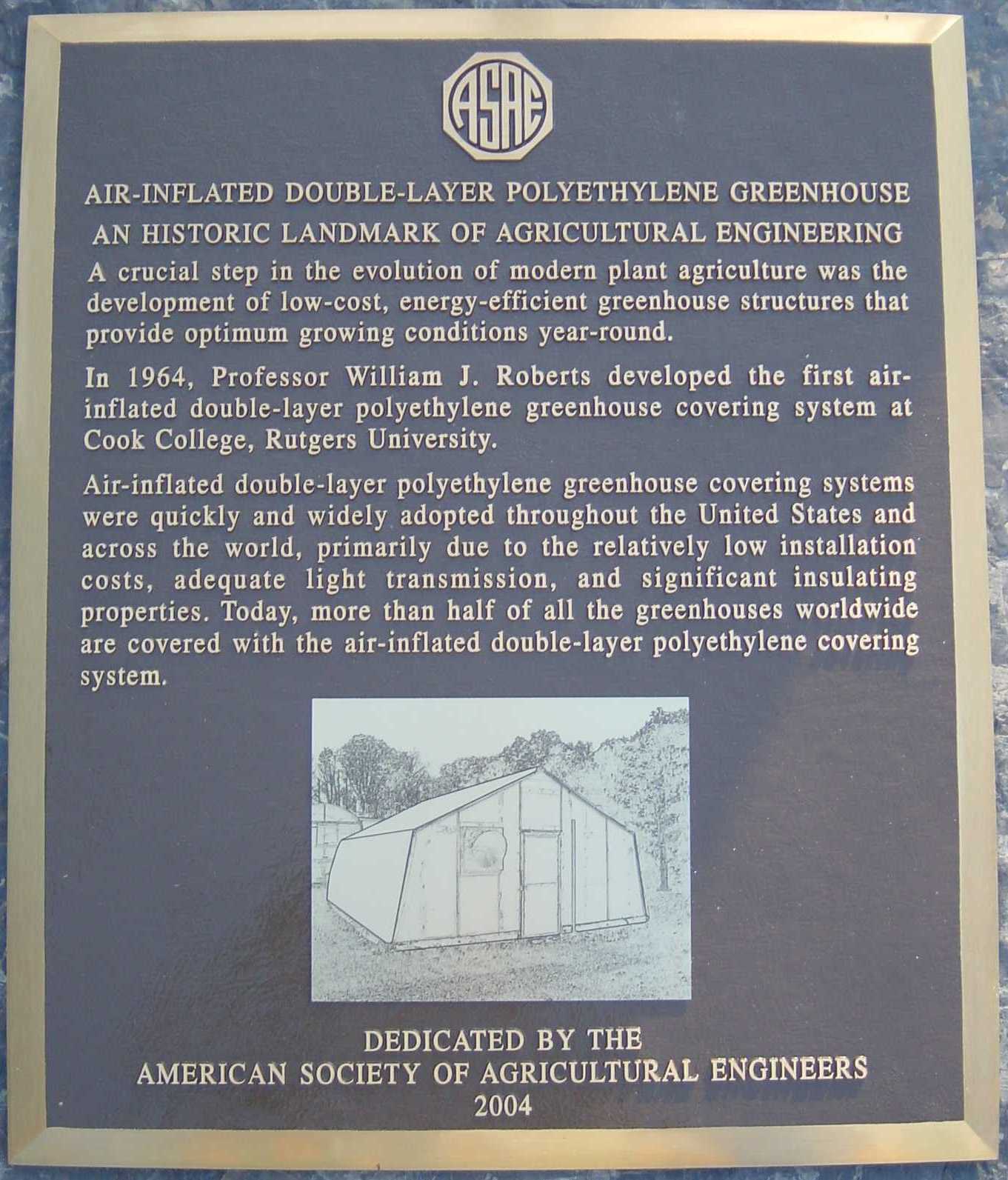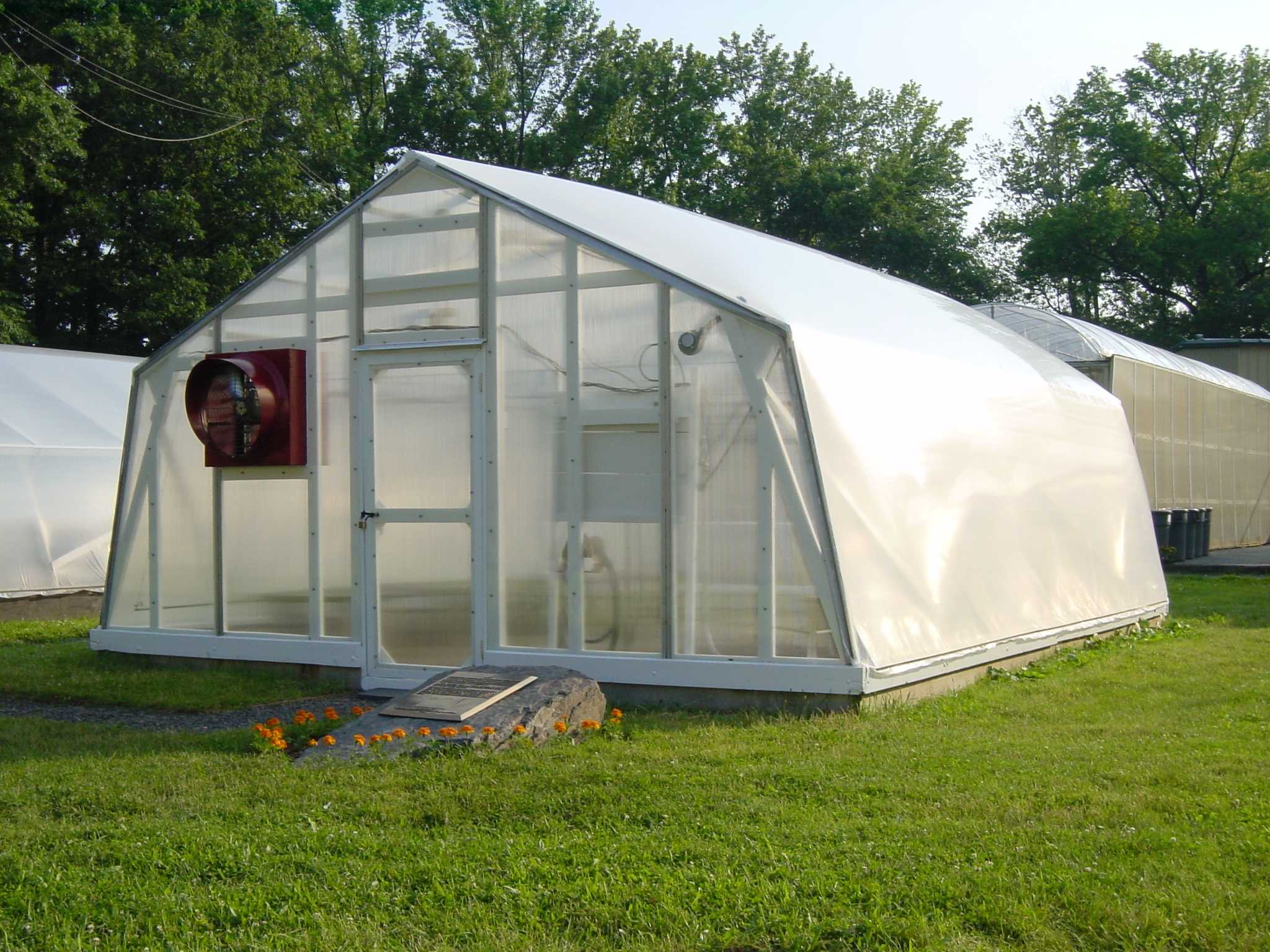| ASAE
Historic Landmark Dedication
|
|
June
4,
2004 Cook
College Rutgers
University New
Brunswick, NJ 08901 Historic
Landmark ASAE
(The Society for Engineering in Agricultural, Food, and Biological
Systems) has dedicate History In
the early 1960's, as extension Agricultural Engineer, Bill Roberts was
working with some growers who were using low-cost polyethylene film on
simple wooden frames to construct greenhouses used primarily for spring
transplant production and for bedding plant operations. One early
concern was the tendency for a single layered roof to collect
condensation that dripped on the small seedlings causing problems. To
ameliorate this problem, a second layer of film was added by fastening
it to the underside of the frame creating an airspace, and keeping the
inner layer warmer. This was a cumbersome process so the next step was
to install a single layer over the frame and fasten it to the rafters
with 2x2 spacers then add on a second layer on top of the 2x2's and
fasten it down with a 1x2. This was an improvement but still required
two fastening steps for every rafter. There had
been some experimentation at Rutgers University on using a fan to create
a bubble house from a single sheet of plastic with the edges buried in
the ground. Recognizing the importance of the double layer covering on a
greenhouse to reduce condensation, Bill tried fastening two sheets
together around all four edges and used a small, low-pressure fan to
inflate the space between. The proposed landmark is the first greenhouse
on which this concept was successfully applied and is a wooden frame
structure designed for the width of polyethylene sheeting available at
the time. It was quickly noted that not only was there a significant
reduction in the required construction materials and labor time, but the
tension in the film due to the slight air pressure reduced the film
flexing and flapping in the wind, reducing the likelihood of tearing the
film, thereby increasing structural reliability and extending film life. This concept
was next applied to a portion of a large, gutter-connected
commercial greenhouse in Allentown NJ, (Kube-Pak, Inc., then managed by
Aart VanWingerden). Several companies then developed frame structures
for multi-span and single span structures. Probably first among these
were VanWingerden with steel frames and PolyGrower with aluminum. Bill
also designed wooden greenhouse frames of several sizes to match
available film widths, as well as a pipe frame structure and pipe bender
to assist hand bending of the hoops. He developed the engineering plans
and drawings for these easy-to-construct greenhouses. These plans were
made available through the extension plan service. The early popularity
of these designs and their rapid commercial acceptance was due primarily
to their low-cost relative to conventional greenhouses glazed with
glass or fiberglass. It was also noted that the insulation properties of
the inflated air space reduced heat requirements by over a third, which
became a more highly appreciated advantage in the years of the energy
crisis from 1973 on. Finally, it should be noted that this development
could not have taken place when it did nor have spread into commercial
practices so rapidly and broadly without the contributions of commercial
growers who took the early risks. The leaders among these would be Aart
VanWingerden and Kenneth Bryfogle, who also started the first companies
to provide gutter connected structures of steel and aluminum,
respectively, and Frank Stuppy who developed the first extruded aluminum
film fastener.
David Mears
worked with Bill Roberts on some aspects of the early research and
contributed the engineering analysis of film stress as related to the
geometry and size of the coverings and the structural loads. Later,
David and a series of graduate students advised by him and Bill did
further research on structural aspects, energy conservation and
management, film properties and other issues associated with a series of
advances in the technology. The key to all of these advances was the
simplicity and functionality of the concept of using air to inflate the
space between the layers, a concept that was developed by Bill.
Impact In 1999,
approximately 9,250 ha (23,125 acres) of air-inflated double-layer
polyethylene greenhouses were in production in the US (682,050 ha or
1,705,125 acres worldwide) (Takakura and Fang, 2002, Climate under
Cover, 2nd edition, 190 pp.). Approximately 65% of all commercial
greenhouses in the United States use the air-inflated system. While the
total area for greenhouse production may seem small, production in these
greenhouses occurs year-round, often producing multiple high-value
crops. Therefore, the production on an area basis is much higher in
greenhouses compared to field production. In addition, especially in
lower-income countries, the AIDLPG is the only economic alternative for
year-round production helping local farmers secure living wages and
providing the local population with affordable produce even when adverse
weather conditions prevent outdoor production. The total worldwide area
in 2003 is estimated at 3,000 square miles (the quoted 1999 data plus
12%, representing a 4% annual increase which was the annual increase
reported in the reference between 1991 and 1999) or roughly the size of
the states of Delaware and Rhode Island combined. The development of the
AIDLPG at Rutgers University set in motion successive developments of
the movable thermal insulation screens and in-floor root zone heating
systems. All three of these developments were included in the list of
outstanding achievements of the 20th century in Agricultural Engineering
as described in Resource Magazine (March 2000, pg 19). While much of the
research at Rutgers University leading to subsequent advances in
greenhouse engineering has been conducted in other facilities, the
original AIDLPG structure has also been used continuously for a variety
of research studies. It was also the first unit in which developments in
floor heating and movable insulation/shade curtains were attempted. The
method of fastening the film has been upgraded from the original wooden
strip fastening method (Roberts and Mears, 1969) to various designs
involving aluminum extrusions. Otherwise, the AIDLPG frame is the
original to this date.
Related
References Roberts,
W.J. and D.R. Mears. 1969. Double covering a film greenhouse using air
to separate film layers. Transactions of the ASAE 12(1):32-33, 38. Roberts,
W.J., M.K. Kim, and D.R. Mears. 1972. Air inflated and air supported
Mears,
D.R., M.K. Kim, and W.J. Roberts. 1976. Structural analysis of an
experimental cable supported air-inflated greenhouse. Transactions of
the ASAE 19(5):915-919, 924. Simpkins,
J.C., D.R. Mears, and W.J. Roberts. 1976. Reducing heat losses in
polyethylene covered greenhouses. Transactions of the ASAE
19(4):714-719. Simpkins,
J.C., D.R. Mears, and W.J. Roberts. 1984. Evaluation of an experimental
greenhouse film with improved energy performance. ASAE Paper No.
84-4033. Mini
Symposium Program Mini
Symposium Program Associated with the ASAE Historic Landmark Dedication Date:
Friday June 4, 2004 Location:
Extension Conference Center, Cook College, New Brunswick, NJ Master
of Ceremonies: Dr. K.C. Ting (Ohio State University) 1:30
1:45 pm Welcome by
the Acting Executive Dean of Cook College, Dr. Keith
Cooper 1:45
2:00 pm Remarks by ASAE
President Dr. Robert Gustafson (Ohio State
University), followed by unveiling of the plaque 2:00 2:30 pm The world-wide impact of double-poly greenhouses, Dr. Merle Jensen, University of Arizona, (view presentation) 2:30
3:00 pm Double-poly and
natural ventilation, Dr. Sadanori Sase, National Institute for Rural
Engineering, Japan 3:00
3:30 pm Double
layer poly in Taiwan and its
potential applications, Dr. Philip Fang, National Taiwan
University, Taiwan 3:30
4:00 pm Greenhouse
glazing with plastic and how to fasten it,
Dr. David Mears, Rutgers University 4:00
4:30 pm Personal
recollections, Professor Emeritus Bill Roberts, Rutgers University 4:30
5:30 pm Tour of the
first Air-Inflated Double-Layer Polyethylene Greenhouse
|



